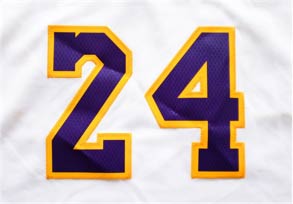Nominal numbers
A nominal number is a number, or more specifically, a numeral, that is used as a label or a way of identifying something. Nominal numbers are usually discussed along with cardinal numbers and ordinal numbers.
One example of a nominal number is a jersey number.

The figure above shows a white jersey with the number 24 on it. You may recognize the jersey above as Kobe Bryant's due to the design. Within his team, the number 24 only referred to Kobe Bryant. His teammates all had other numbers on their jerseys that specifically identified them. The numbers on their jerseys are all nominal numbers in that they do not indicate anything about the number of people on the team, their rank, etc. The number just distinguishes one player on a given team from another (in some cases the numbers may indicate something about what position the player plays).
Other examples of nominal numbers include a cell phone number, social security number, zip code, passport number, and many more. Though all of these numbers specify some specific thing, the numbers have no real meaning relative to another number of the same kind. Given two passport numbers for example, you typically wouldn't be able to tell which passport was issued first, where or when it was issued, or anything else without actually having the documents in hand.
Nominal, cardinal, and ordinal numbers
These three types of numbers are often discussed together since it is necessary to understand them in order to effectively communicate using numbers. Briefly, a cardinal number differs from a nominal number in that cardinal numbers are used for counting. While the number 24 on the jersey above just identifies that specific person, the cardinal number 24 would reflect a count of something, such as the total number of players on the team.
Ordinal numbers, unlike cardinal or nominal numbers, tell us something about order, rank, or position. They can be identified by using terms such as first, second, third, and fourth to represent the cardinal numbers 1, 2, 3, and 4.
As an example that includes the use of all three types of numbers, imagine that there are 15 people running in a race. 15 is a cardinal number. The participants in the race are assigned the numbers 1-15 depending on when they registered for the race. Their respective numbers are nominal numbers. Only the three people who finish the race fastest get a prize based on whether they ranked first, second, or third. First, second, and third are ordinal numbers.
